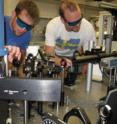Discovery brings new type of fast computers closer to reality
Their discovery, detailed this week in the advance online issue of the journal Nature Photonics, follows the team's demonstration last summer of an integrated circuit—an assembly of transistors that is the building block for all electronic devices—capable of working at 1.5 degrees Kelvin above absolute zero. That temperature, equivalent to minus 457 degrees Fahrenheit, is not only less than the average temperature of deep space, but achievable only in special research laboratories. Now the scientists report that they have succeeded in building an integrated circuit that operates at 125 degrees Kelvin, a temperature that while still a chilly minus 234 degrees Fahrenheit, can be easily attained commercially with liquid nitrogen, a substance that costs about as much per liter as gasoline.
"Our goal is to create efficient devices based on excitons that are operational at room temperature and can replace electronic devices where a high interconnection speed is important," said Leonid Butov, a professor of physics at UCSD, who headed the research team. "We're still in an early stage of development. Our team has only recently demonstrated the proof of principle for a transistor based on excitons and research is in progress."
Excitons are pairs of negatively charged electrons and positively charged "holes" that can be created by light in a semiconductor such as gallium arsenide. When the electron and hole recombine, the exciton decays and releases its energy as a flash of light.
The fact that excitons can be converted into light makes excitonic devices faster and more efficient than conventional electronic devices with optical interfaces, which use electrons for computation and must then convert them to light for use in communications devices.
"Our transistors process signals using excitons, which like electrons can be controlled with electrical voltages, but unlike electrons transform into photons at the output of the circuit," Butov said. "This direct coupling of excitons to photons allows us to link computation and communication."
Source: University of California - San Diego
Other sources
- Speedier computer circuits createdfrom UPIMon, 28 Sep 2009, 19:56:29 UTC
- Discovery brings new type of fast computers closer to realityfrom Science BlogSun, 27 Sep 2009, 23:49:07 UTC
- Discovery Brings New Type Of Fast Computers Closer To Realityfrom Science DailySun, 27 Sep 2009, 21:28:05 UTC
- Discovery brings new type of fast computers closer to realityfrom Science BlogSun, 27 Sep 2009, 18:56:20 UTC
- Discovery brings new type of fast computers closer to realityfrom PhysorgSun, 27 Sep 2009, 18:56:15 UTC
